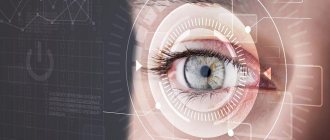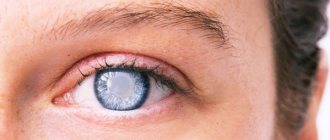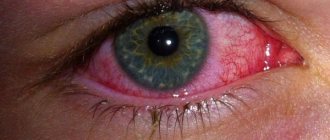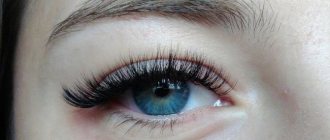Home / Articles / Sharp decrease in visual acuity
Vision is precious for every person, because through it we receive more than 80% of information about the world around us. Unfortunately, visual acuity decreases over the years due to inevitable age-related changes in the body. If this process develops gradually, a person has the opportunity to adapt to this, select correction means (glasses or contact lenses) and carry out therapeutic measures. But it’s a completely different matter when vision loss occurs sharply and suddenly.
Causes
During myopia, the work of the ciliary muscles of the eye is disrupted, the lens takes on an irregular shape, so a person has difficulty seeing surrounding objects. Trying to concentrate on them, he involuntarily tenses the muscles located around the eyeball and lens. Constant overvoltage leads to continuous transmission of nerve impulses to the brain, and a spasm of accommodation is formed.
During spasm, blood circulation through the vessels to the eyeballs is disrupted. This results in a reduced amount of oxygen supplied. This causes a headache. If a person puts on glasses or contacts, he stops straining his eye muscles. Therefore, blood circulation is normalized and headaches are eliminated.
Headache may additionally develop due to the following effects on visual function:
- prolonged use of a computer, telephone, TV;
- reading small print in poor lighting;
- farsightedness;
- astigmatism;
- violation of eye accommodation.
Causes of headaches with blurred vision
Often, your health worsens due to headaches. And this disease is often directly related to the general condition of the body. But most of the load on the brain comes through the organs of touch, which is why when working a person gets headaches and blurred vision on an ongoing basis.
A sharp deterioration in vision and headache together are detected when:
- Overwork;
- Migraine;
- Problems with the vascular system;
- Injuries to the head or organs of vision.
How are headaches and decreased visual acuity related?
Understanding the issue as thoroughly as possible, it is important to know that the causes of headaches and visual acuity are connected by:
- Astigmatism;
- Hypermetropia;
- Presbyopia;
- Increased pressure (glaucoma with painful symptoms).
It is most clearly visible when a child’s vision has sharply deteriorated, then such an ailment is expressed in migraines - this is a very severe headache, blurred vision, weakness and nausea.
The disease is expressed in the form of bright flashing dots or wavy lines, even temporary blindness is acceptable. When this does not happen, but there is a headache, then this type of migraine is called auraless.
A visual symptom without a headache, on the other hand, is called a silent migraine.
Why does nausea and weakness occur with vision loss?
A peculiar set of symptoms (headache and blurred vision) can be caused by the following factors:
- Peripheral visual impairment. This is when the vestibular nerve to the inner ear is damaged. Most often, it is pain in the eye due to decreased vision.
- Central nervous system. Here the problem is in the cerebellum and its changes. This disease process is related to the brain.
- Physiological features. Difficulties with the vestibular system associated with hunger (low glucose levels), stressful situations (there is a lot of adrenaline in the body, which can cause vascular spasms in the brain).
- Overfatigue and motion sickness in any type of transport. It is overfatigue that affects the overload of the eye system, hence the circulatory and nervous system suffers.
- Pathologies. This is a complex of deterioration (namely vision), when there is damage and dysfunction of the cerebellum. The links of the latter are connected with the vestibular and visual apparatus, facial muscles and motor skills of the whole body.
If we focus on nausea, then this reflex process is associated with the medulla oblongata. Signals from the brain pass through it, which often reacts this way to hormonal disruptions and changes in blood glucose.
Solution
Most diseases of the visual system that occur in the brain are compensated with the help of precision spectacle correction. The detection of the disease is carried out in the usual way - an extraordinary check with an ophthalmologist. Doctors have the right to prescribe a number of other procedures, realizing that the headache is due to decreased vision.
There are a lot of common exercises on the Internet according to Zhdanov, Norbekov and Bates if you search for “eye, vision and headache”. But it is more effective to relieve the load on the eye apparatus, which turns into a headache, using a comprehensive approach:
- Draw the outline of the nose. These are wonderful exercises for relaxing the eyes (the eyelids, of course, close in the process), but also for the cervical region. This complex is much more effective if performed in a position comfortable for the whole body. To distract yourself from work processes, it is important to imagine a visual drawing with your eyes closed. And let it look stupid from the outside. Health is more valuable.
- Palpation. To help tired muscles. Both eyes are covered with the palms of your hands with a light touch. It is advisable to spend a few minutes in this position, distracting yourself from the hustle and bustle of everyday life.
- Infinity sign or figure eight. Open your eyes and draw a figure eight horizontally to its full amplitude. It is important to do the exercise slowly, stretching your figure as wide as possible.
- Blinking or blind man's buff. The eyes are closed tightly for 2-5 seconds, followed by a sharp opening for a similar time.
- Massage your eyes with your fingertips. We massage the eyelids with warm fingers, directing movements from the corner of the eyes to the inside. And then moving in the opposite direction. At the same time, it is important to monitor your breathing - it is as even and deep as possible. Then we give the visual apparatus a break by closing the eyeballs for 2-5 seconds.
- Forced eye movements randomly to the sides. It is important to go through all possible vectors so that most of the muscles of the eyeballs are strengthened.
Laser correction
Before laser correction, any patient needs to undergo a full cycle of studies. This is performed in an ophthalmologist's office. Using special equipment, doctors evaluate the patients’ eyeballs and the degree of astigmatism, determine their depth, and take measurements of the eye wall.
You need to know all this for future procedures. It is also important for the patient to know that before operations, drops are instilled that impair vision for a period of 2 to 5 hours. During this period, diagnostics and subsequent surgical interventions are performed. I also have headaches and eye pain after laser vision correction.
Visual gymnastics
Exactly the exercises with the visual apparatus necessary to maintain muscle tone are what is necessary for headaches and blurred vision.
Here it is important to understand what the result of a whole set of exercises is, at least for a few days (hours). It is not always possible to bypass genetics and cure what nature has already caused to worsen.
As a gymnastics for the visual muscles and nerves in the modern world, it is most convenient to perform accommodation. If it’s completely clear, this is work on focusing control.
The eyes need to concentrate on objects concentrated at different distances. Under such conditions, the muscular apparatus of each eyeball is reconfigured, and a kind of temporary pumping occurs.
This charging improves the clarity of the image on the retina.
Do your eyeballs really hurt when you work at the computer for a long time?
It was clinical observations that showed patterns when long concentration of attention on a computer display causes either farsightedness or myopia.
Daily workload on the eyes for 6-8 hours causes spasm of the ciliary muscles. This is the result of constant stress, and if you do not periodically refocus, then the transition to accommodation is useless over time.
Simply put, part of the visual system will lose flexibility forever.
But timely work (training) of the cylindrical muscle maintains normal eye functions. It turns out that in some cases headaches due to deterioration of vision can actually be prevented not with drugs, but with simple eye exercises. This prevents early symptoms of myopia, farsightedness, and astigmatism.
Our recommendations
It is important to understand that it is impossible to completely eliminate headaches; vision deteriorates anyway. At -3 diopters (and below), only through gymnastics is it possible to maintain the visual apparatus in good shape. In such situations, the eyeball (its shape) is changed. It simply cannot be restored.
Recommendations:
- You need to train your eyes (accommodation, refocusing). This will have a better effect.
- The process of relieving headaches is associated with a set of measures. And for each case they are individual. It is best to get examined in a good clinic.
- It is not advisable to relieve poor vision and pain in the eyeballs with general-purpose tablets. It is much more effective to understand the nature of the disease.
conclusions
Poor vision and constant headaches are a common ailment in modern society. And if this begins to happen with age, then simple gymnastics and proper nutrition will not always help. It is important to give up bad habits, start listening to your body and choose the time to visit a medical specialist as soon as possible.
After all, headaches and loss of vision, the subtleties of all problems are identified strictly in a medical institution, often on a commercial basis.
Source: //www.zrenia.ru/article/prichiny-golovnoy-boli-pri-uhudshenii-zreniya
Relevance
Loss of orientation and lack of coordination due to sudden dizziness can cause fainting, and possibly lead to more serious injury in the event of a fall. Ataxia appears - a violation of normal coordination of movements, which is not associated with muscle weakening. Dizziness can be symptoms of severe disturbances in the functioning of the body.
During sudden dizziness, a person may feel as if he is spinning, or objects around him are spinning.
He loses coordination and cannot control his position in space. This is actually why dizziness got its name. Sometimes it can last only seconds, minutes, and sometimes several hours.
Constant severe dizziness and loss of balance in almost all cases are a consequence of serious mental or neurological abnormalities.
Many people experience dizziness when there is a sudden and sharp change in their position in space, for example, as a result of abruptly getting out of bed in the morning. In medicine, this symptom is called “orthostatic collapse.”
If you have a headache and pressure on your eyes: WHAT to do
Any headache causes severe discomfort. If you have a headache and put pressure on your eyes, this may indicate either overwork or a very serious illness.
Obviously, a headache that radiates to the eyes is a very common symptom, which is why most people are familiar with it firsthand. Despite its commonality, neglecting the condition is unacceptable.
Perhaps the cause of the malaise is harmless, but it may also indicate serious disorders.
If there are no reasons for the pain in the form of stress and lack of sleep, and it does not go away on its own, you should immediately consult a specialist, forgetting about self-diagnosis and self-medication.
Causes of headaches with eye pressure
The symptom of a headache that radiates into the eyes is very common and can indicate a number of problems. The most common reasons:
- Fatigue, eye strain. This is typical for people whose occupation involves constantly sitting at a computer, after watching TV for a long time, or reading books from electronic “readers”.
- Lack of sleep. Glasses or contact lenses that were not fitted correctly. The symptom gets worse throughout the day. Diopters that are not suitable for specific eyes have a negative impact on the optic nerve.
Subscribe to our INSTAGRAM account!
- If discomfort occurs when sneezing and coughing, this indicates high blood pressure.
- Nervous overstrain. “Floaters” may appear before the eyes. Combined with pressing pain in the eyes, this occurs due to spasms of the blood vessels supplying the face and neck.
- After bruises and blows to the head, a migraine with pressure in the eyes in this case may indicate a concussion.
- Glaucoma, migraine and other diseases.
- Constant jerking pain occurs in dangerous conditions: meningitis, sarcoma, encephalitis, aneurysm.
- Allergic reaction.
The list of causes of the symptom is very large, so it is important to consult a doctor and not self-medicate, especially if the phenomenon does not go away for a long time.
Forehead hurts and puts pressure on eyes
Most often, pain in the head in the forehead area radiates to the eyes. They may indicate unexpected problems in the body.
Poisoning
For your information! Toxins in industrial products may cause this symptom. Often found among sellers and warehouse workers.
To avoid permanent poisoning, it is advisable to avoid furniture or household appliances with a strong chemical odor. If you experience any discomfort, pay attention to your recent purchases - they may have caused your discomfort.
A similar reason is a reaction to components of food additives: nitrates, monosodium glutamate, etc.
The symptom also occurs with an allergy to citrus fruits.
ENT diseases
Possible diseases that are characterized by this symptom:
- Sinusitis. The disease is accompanied by headache and eye pain, runny nose, and fever. The sensations can be very strong, and the condition is regarded as dangerous due to the proximity of the inflammatory process to the brain.
- Inflammation of the mucous membranes of the frontal sinuses - Frontitis . Characterized by pain after waking up.
- Inflammation of the ethmoid sinus in the skull - Ethmoiditis . Occurs in children, as well as adults with weak immunity.
Eye diseases
The described symptom can be accompanied by all common eye diseases: astigmatism, conjunctivitis, myopia, etc.
Remember! If you notice such defects, as well as with constant migraines due to overexertion at the computer, you should contact an ophthalmologist.
Subscribe to our Yandex Zen channel!
Nervous system diseases
The forehead hurts and puts pressure on the eyes when there are disorders:
- Migraine. A very common problem with sharp throbbing pain in different parts of the head, including the forehead.
- Neurosis. Typical for easily excitable people, other symptoms may be absent. It is quite difficult to determine neurosis; most often it is diagnosed by excluding other possible causes.
- Cluster pain . They are characterized by the presence of redness and watery eyes, very sharp, unbearable pain. At risk are people who have recently abruptly changed their climate zone, abuse alcohol, and smoke.
Viral and infectious causes
Unpleasant sensations in the frontal part with pressure in the eyes are typical for influenza, ARVI, meningitis, encephalitis, and colds.
The infectious or viral origin of migraine is indicated by high fever, muscle pain, and signs of intoxication. The most serious in this series are encephalitis and meningitis . They may experience loss of consciousness.
Viral diseases transmitted through insect bites and characterized by a similar feeling are all kinds of fevers that travelers can bring from southern countries.
Cancers
Carefully! Oncology also causes the same sensations, which can be localized in the frontal part and radiate to the eyes. These are the most dangerous disorders that have this symptom.
In the case of migraine headaches, the tumor may be located in different parts of the head. It is possible to distinguish the oncological origin of a symptom because it is observed for a long time and constantly. Therefore, in such cases, you should immediately consult a doctor. Ignoring a persistent painful condition can lead to an advanced situation where it will no longer be possible to get rid of the disease.
While promptly contacting a doctor when a symptom occurs can save health and even life, ensuring a complete cure for the patient in the early stages of malignancy.
Pain in the crown
Much less common is an unpleasant sensation in the top of the head that radiates to the eyes. It may indicate violations:
- muscle strain;
- head injury and concussion;
- osteochondrosis;
- migraine.
Keep in mind! Similar symptoms appear in people who smoke and abuse alcohol, under stress, emotional stress, and cluster pain.
Heaviness and pressure in the temples
This symptom is familiar to many; it feels like the head is being squeezed in a steel vice, and the pressure on the eyes can be very pronounced. Such sensations may occur from time to time or be regular.
In the first case, you don’t need to worry right away; most likely, you just need to change your routine, get enough sleep and rest.
In case of constant or very severe attacks, you need to contact a specialist.
The main causes of heaviness in the temples with pressure on the eyes from the inside:
- Circulatory disorders, possible vegetative-vascular dystonia.
- High blood pressure.
- Flu, cold.
- Migraine. They usually begin with a migraine in the temporal part and then spread to other areas of the head.
- Poisoning.
- Hormonal reasons.
- Neurology.
- Psychogenic causes of constant stress.
Oncological diseases and cervical osteochondrosis are rarely accompanied by migraine in the temporal part.
Headache and nausea
Important! Nausea due to pain in the head can occur with almost any disease. However, you need to pay special attention to this symptom, since it is characteristic of dangerous diseases:
- Sarcoma of the brain. In addition to nausea, vomiting occurs and severe dizziness is possible. It is very important to see a doctor immediately.
- Glaucoma. It is also characterized by redness of the eyes, deterioration of vision, and a bright halo ring may appear in the field of vision around the objects in question.
When to sound the alarm?
Headache occurs in almost every person, and it is usually neglected and the worsening of the condition is missed. In the following cases, seeing a doctor can help you avoid conditions that are very dangerous to your health and life:
- Suddenly there was pain that had never existed before.
- Regular painkillers do not help within three days.
- The phenomenon is very pronounced, it is impossible to tolerate.
- There are other symptoms: weakness or pain in muscles and joints, previously unobserved visual and coordination problems, and difficulty speaking.
- Increased pain with habitual physical activity.
- It becomes impossible to turn the neck, the temperature rises.
- Sudden vomiting appears, without nausea.
In case of all these phenomena, you should urgently consult a doctor to diagnose and treat the underlying disease.
Prevention
It is worth noting! As a preventive measure, you need to reconsider your lifestyle, limit bad habits, get enough sleep, not overwork, and sit less at the computer.
- Regular eye exercises are recommended if your activities involve eye strain.
- Outdoor walks are recommended .
- A good result with frequent, but not very severe discomfort is achieved by fitness classes and massage of the head, shoulders, neck, adherence to proper nutrition and drinking regime .
Such methods will allow you to avoid illness due to overexertion and the like, but will not eliminate the risk of other diseases that require medical intervention. published econet.ru.
on the topic of the article here
PS And remember, just by changing your consumption, we are changing the world together! © econet
Source: https://econet.ru/articles/esli-bolit-golova-i-davit-na-glaza-chto-delat
Risk group
The risk group includes the following categories of patients:
- people whose parents suffer from visual impairment;
- persons with disorders of the internal structures of the eyes, various diseases (glaucoma, cataracts, retinal detachment, dysfunction of the optic nerve);
- persons who work at a computer for a long time;
- patients who selected optical devices without a doctor’s recommendation (there may be a risk of incorrect selection of lenses for glasses, incorrect diopter).
Atrial scotoma during pregnancy
Ocular migraine during pregnancy in most cases is observed only in the first trimester. The main causes of the disease are disturbances in sleep patterns and daily routines, poor nutrition, and deficiency of beneficial micro- and macroelements and vitamins. After the first three months after conception, the symptoms of ocular migraine in the expectant mother disappear, but there are known cases of manifestations of the disease throughout the entire period of pregnancy.
Self-treatment of the disease is unacceptable, which is due to the ban on the use of most medications. The use of traditional medicine without prior medical consultation is also prohibited.
To minimize the frequency of ocular migraine (atrial fibrillation) for pregnant women, the following recommendations have been developed:
- frequent long rest in the fresh air;
- lack of significant physical activity;
- light exercise, gymnastics;
- avoidance of stressful situations;
- alternative medicine techniques - reflexology, acupuncture, yoga (possible only after prior medical consultation).
By following basic preventive rules, you can significantly reduce the frequency of relapses of atrial scotoma or completely get rid of the disease.
Is headache one of the symptoms of decreased vision?
Headache and decreased vision are often interrelated and occur simultaneously. At the same time, it is sometimes difficult to determine what is the cause and what is the effect. So can a headache be considered a symptom of visual impairment and what should be done in such cases?
Deterioration of vision is indeed often accompanied by pain in the center of the forehead and above the eyebrows.
This is due to the fact that with myopia, especially progressive one, a person has to constantly strain the eye muscles in order to properly see the surrounding objects.
Constant overload causes discomfort. The pain in this case is aching, most often it is uniform, does not intensify or weaken.
There is another possible reason for a headache due to deteriorating vision: simple fatigue when working at a computer for a long time or reading text in very small print, especially in poor lighting. Such a load can lead to a noticeable, but short-term drop in visual acuity, and also causes painful sensations similar to those described in the first case.
Why does my head hurt and put pressure on my eyes?
Doctors give an impressive list of reasons. In most cases, timely initiation of treatment allows you to quickly and completely get rid of the unpleasant syndrome. The main thing is not to delay going to the doctor, not to try to solve the problem with the help of painkillers and not to get carried away with traditional medicine without the permission of a specialist.
Pain in the eyes always indicates possible ophthalmological disorders.
But it is impossible to make a diagnosis solely on the basis of the very fact of having headaches.
A complete examination of the visual organs and identification of additional specific symptoms that develop with eye pain are required.
One of these symptoms is dizziness, which can indicate either overwork or occur with more serious problems.
Symptoms
Symptoms of the condition depend on the underlying cause that caused decreased visual acuity and headache.
The most common signs are:
- poor health, loss of strength;
- double vision;
- increased blood or intraocular pressure;
- the eyes become tense, dry mucous membranes and overwork of the eyeballs may develop;
- migraine occurs.
A person may have only a headache or be accompanied by the above symptoms.
Hearing impairment
Hearing impairment and deterioration are most often unilateral; in the later development of the disease, bilateral impairment/deterioration appears (mainly after approximately 5 years of the disease, sometimes later).
Hearing loss begins suddenly (sometimes the disorder is characterized by noise, ringing and mild pain in the ears).
Ringing or tinnitus is often a symptom immediately followed by dizziness.
Ringing or tinnitus is primarily felt in the ear itself, rarely in the head. The grip usually gets stronger and loosens again. As a rule, noise or ringing in the ears is characterized by deeper tones, mainly at frequencies of 250-500 Hz.
Patients often describe ringing or noise in the ears as being like the sound of the sea, the growl of an engine, and in later stages the symptoms become more like the sound of a forest or the buzzing of bees.
Diagnostics
Diagnosis of a person’s condition is carried out in several stages:
- Anamnesis collection. This is information obtained from the words of the patient or his close relatives. Based on it, the doctor may prescribe additional research methods.
- Examination of the superficial tissues of the eyes, measuring blood pressure, studying the general condition of the patient.
- Examination of the fundus after instillation of a solution that disrupts pupil accommodation. The doctor diagnoses the condition of the lens, eye chambers, and retina.
- Laboratory tests, including general blood and urine analysis, blood biochemistry. Next, specific research methods are prescribed if any abnormalities are detected in general clinical tests, for example, testing for tumor markers.
- MRI, . Prescribed if any disease is suspected. By viewing the internal structures of the body, you can confirm the diagnosis proposed by the doctor.
Based on diagnostic procedures, the doctor prescribes the treatment most suitable for the patient.
Why does nausea and weakness occur with vision loss?
A peculiar set of symptoms (headache and blurred vision) can be caused by the following factors:
- Peripheral visual impairment. This is when the vestibular nerve to the inner ear is damaged. Most often, it is pain in the eye due to decreased vision.
- Central nervous system. Here the problem is in the cerebellum and its changes. This disease process is related to the brain.
- Physiological features. Difficulties with the vestibular system associated with hunger (low glucose levels), stressful situations (there is a lot of adrenaline in the body, which can cause vascular spasms in the brain).
- Overfatigue and motion sickness in any type of transport. It is overfatigue that affects the overload of the eye system, hence the circulatory and nervous system suffers.
- Pathologies. This is a complex of deterioration (namely vision), when there is damage and dysfunction of the cerebellum. The links of the latter are connected with the vestibular and visual apparatus, facial muscles and motor skills of the whole body.
Headache, poor vision
A severe headache can strike any person, and there can be many reasons, but pain radiating into the eye should be alarming - it could be a signal of a dangerous pathology.
If headaches and discomfort in the eyes recur frequently, forcing a person to interrupt work, or interfere with a quality night’s rest, it is recommended to consult a specialist and undergo a comprehensive diagnostic examination.
External reasons
During the consultation, the specialist will ask the person in detail exactly how his head hurts, whether there is irradiation into the eyes, and whether there is a relationship with external negative stimuli.
Provoking factors:
• prolonged exposure to a computer monitor, especially without the use of protective equipment, for example, special glasses;
• often the reason that a person has a headache and feels like sand has been poured into his eyes is wearing the wrong glasses or dirty lenses - at the slightest discomfort, if it intensifies, as soon as the person puts on glasses, it is necessary to correct the diopters or change the lenses;
• if the pain radiates to the head from other areas of the body, for example, from the neck, then the cause may be banal overwork - constant tension of muscle tissue provokes a condition called by specialists “tension syndrome,” when discomfort is caused by overstrain of nerve endings. The eyes may not suffer.
It is recommended to analyze the person’s lifestyle. For example, spasms of intracranial vessels may be completely caused by existing negative habits - abuse of tobacco and alcohol products.
Frequent consumption of various energy drinks, coffee, strong tea, poor quality night rest, chronic stressful situations can cause a person to feel pain, twitch the eye, his temples often hurt, and decreased vision and performance.
Internal reasons
To date, experts have identified many pathologies accompanied by pain in the head and eyes. Modern diagnostic tests help identify the leading root cause.
Headache radiating to the eyes can be caused by:
• the presence of a person’s tendency to high blood pressure – hypertension. It is the spasm of the intracranial vessels, which causes the state of ischemia of the brain structures, that causes discomfort in some area of the head, for example, the left eye hurts more;
• similar phenomena can be observed with a congenital tendency to vascular spasms - migraine. The head may be covered in a hoop of pain, accompanied by nausea, hyperreactivity to light and noise. There is also an acquired version of migraine - in this case, to prevent it, it is enough to avoid provoking factors;
• sometimes a person notes that it hurts only on one side of the head, unpleasant sensations are present in the ear, temporal region, eye area on one side or both.
The attack is provoked by a sharp turn to the side, overexertion in the shoulder girdle.
After diagnostic studies, in this case, cervical osteochondrosis will be identified as the root cause of the pain syndrome arising after compression of the cervical artery by modified vertebrae;
• pathologies of the visual apparatus - inflammatory, traumatic in nature - can become a provoking factor.
The pain can be caused by overstrain of the muscle fibers that help the eyeball move to the sides, by the entry of a foreign body into the conjunctival sac, allergic manifestations are also reflected by a feeling of discomfort - the eye is watery, the tissues are swollen, hyperemic;
• the head and eyes can also hurt due to pathologies, sometimes localized in other areas of the body, for example, with autoimmune herpetic lesions. A person complains of pain in the area of the eyes, and one of the branches of the trigeminal nerve is affected, or the local blood supply in the retroocular space is disrupted and the outflow of ocular fluid is obstructed.
General recommendations
The important point is not the fight against pain, even when the pain impulse radiates into the eyes, but the elimination of the cause of such symptoms.
General recommendations:
1. Visit a specialist.
2. Undergo a comprehensive comprehensive examination.
3. Reconsider your own lifestyle.
4. Ensure a quality night's rest.
5. Adjust your diet - give up strong drinks, rich broths, many spices, sauces, preservatives, smoked meats.
6. Maintain adequate drinking regime.
7. Try to walk more in the fresh air.
8. Observe the work and rest schedule.
9. Master yoga or relaxation complexes.
10. Visit the pool and fitness room more often.
Compliance with the above fairly simple recommendations helps to avoid a state of insufficiency of oxygen and nutrients in the body, which will be an excellent prevention of various pathologies that cause pain in the eye, the back of the head, and severe discomfort in other parts of the body.
It is useful for people suffering from migraine attacks and hypertensive crises to keep a diary, which indicates the time of occurrence of unpleasant sensations, what caused them, and whether the recommended medications helped. At the slightest deterioration in health, for example, the vision in the eye has become worse, the headache has intensified, it is necessary to consult a specialist again.
Drug therapy
To relieve pain, the following can be used as symptomatic therapy:
1. A subgroup of anti-inflammatory non-steroidal drugs - they help stop the production of substances that cause pain.
2. Antispasmodics - dilate blood vessels in the area of the brain where local ischemia has occurred, causing pain impulses in the head and eyes.
Source: https://novosibmemorial.ru/golovnaja-bol-ploho-vidit-glaz/
Treatment
Therapeutic measures are based on the cause that caused the disorder:
- prescription of glasses and lenses that correct decreased visual acuity;
- drugs against glaucoma, cataracts, prescribed in the form of drops;
- medications that lower blood pressure;
- anti-inflammatory drugs;
- surgical methods to restore damaged tissues;
- surgical removal of malignant and benign tumors.
If any serious systemic disease is detected, specific therapy is prescribed. After complete healing, the headaches will go away on their own.
Complications
When visual acuity decreases, accompanied by headache, various complications are possible, which depend on the cause of the condition:
- internal bleeding in the eye or brain;
- a sharp decrease in visual acuity up to complete blindness;
- spread of metastases from a malignant neoplasm;
- compression of neighboring tissues by a benign tumor;
- progression of cataracts, glaucoma, which sharply reduces vision to complete blindness;
- spread of the infectious process to adjacent tissues and into the blood.
To avoid complications, it is recommended to start therapeutic measures prescribed by your doctor on time.
Headaches and decreased vision
With the onset of myopia and the progression of this process, headaches often appear, especially if the person does not use optical devices to improve the quality of vision.
To diagnose the cause of headaches, it is recommended to consult an ophthalmologist. He will examine the patient’s fundus, make an accurate diagnosis, and prescribe treatment that eliminates this effect.
Risk group
The risk group includes the following categories of patients:
- people whose parents suffer from visual impairment;
- persons with disorders of the internal structures of the eyes, various diseases (glaucoma, cataracts, retinal detachment, dysfunction of the optic nerve);
- persons who work at a computer for a long time;
- patients who selected optical devices without a doctor’s recommendation (there may be a risk of incorrect selection of lenses for glasses, incorrect diopter).
Symptoms
Symptoms of the condition depend on the underlying cause that caused decreased visual acuity and headache.
The most common signs are:
- poor health, loss of strength;
- double vision;
- increased blood or intraocular pressure;
- the eyes become tense, dry mucous membranes and overwork of the eyeballs may develop;
- migraine occurs.
A person may have only a headache or be accompanied by the above symptoms.
Treatment
Therapeutic measures are based on the cause that caused the disorder:
- prescription of glasses and lenses that correct decreased visual acuity;
- drugs against glaucoma, cataracts, prescribed in the form of drops;
- medications that lower blood pressure;
- anti-inflammatory drugs;
- surgical methods to restore damaged tissues;
- surgical removal of malignant and benign tumors.
If any serious systemic disease is detected, specific therapy is prescribed. After complete healing, the headaches will go away on their own.
Complications
When visual acuity decreases, accompanied by headache, various complications are possible, which depend on the cause of the condition:
- internal bleeding in the eye or brain;
- a sharp decrease in visual acuity up to complete blindness;
- spread of metastases from a malignant neoplasm;
- compression of neighboring tissues by a benign tumor;
- progression of cataracts, glaucoma, which sharply reduces vision to complete blindness;
- spread of the infectious process to adjacent tissues and into the blood.
To avoid complications, it is recommended to start therapeutic measures prescribed by your doctor on time.
How are headaches and decreased visual acuity related?
Understanding the issue as thoroughly as possible, it is important to know that the causes of headaches and visual acuity are connected by:
- Astigmatism;
- Hypermetropia;
- Presbyopia;
- Increased pressure (glaucoma with painful symptoms).
It is most clearly visible when a child’s vision has sharply deteriorated, then such an ailment is expressed in migraines - this is a very severe headache, blurred vision, weakness and nausea. The disease is expressed in the form of bright flashing dots or wavy lines, even temporary blindness is acceptable. When this does not happen, but there is a headache, then this type of migraine is called auraless. A visual symptom without a headache, on the other hand, is called a silent migraine.
Headaches are constant and vision has deteriorated
In order to begin treatment, you need to find out exactly why your eyes and head hurt. Preliminary diagnostics can be performed on special resources.
You will need to answer several questions about the location of the pain and all its manifestations. As a result, in just a few minutes you will receive a list of diseases that could cause discomfort.
Under no circumstances should you prescribe treatment based on self-diagnosis. It does not replace consultation with a specialist, but only helps to understand how serious a particular symptom is.
Overwork
In this case, blurred vision and decreased visual acuity are observed, pain is localized in the temples and back of the head. Red eyes appear dry or, on the contrary, become very watery. If you ignore the condition, it will be accompanied by general weakness, weakness, dizziness and nausea.
Blurred vision: causes
It must be said right away that a sharp decrease in vision is almost always a symptom of some disease. The causes of eye problems can be both direct eye pathologies: diseases of the cornea, lens, retina, and general diseases.
Among the eye diseases that most often lead to a sharp decrease in vision are retinal detachment and rupture, macular degeneration, inflammation or ischemia of the optic nerve, rupture or blockage of a vessel.
Also, a common cause of the development of this symptom is diabetic retinopathy, a complication of diabetes mellitus in which damage to the vessels of the retina occurs. With this disease, vision loss is usually irreversible.
In addition, a sharp deterioration in vision can occur with retrobulbar neuritis, intracranial hypertension, intoxication of the body and other pathological conditions.
Tired eyes
Have you become forgetful and is it bothering you a lot? Well, it’s better to seriously understand this phenomenon, because the reasons leading to “leaky memory” can be very serious.
Clinical refraction test (performed by an optometrist or ophthalmologist)
In the case of acute corneal lesions (erosion), corneal ulcers, keratitis, herpes zoster involving the eye, an acute attack of glaucoma, anisocoria will be present, but symptoms such as eye pain and redness of the eye will be much more pronounced.
Rare diseases that lead to the development of anisocoria include hereditary optic neuropathies (Leber's hereditary abiotrophy) and corneal scarring due to vitamin A deficiency.
Examination for blurred vision
In medical language this phenomenon is called amaurosis. Vision loss may be a consequence of retinal detachment or ischemia and other eye diseases (for example, glaucoma or uveitis), damage to the optic nerves, or bilateral damage to the visual cortex.
Patients with acutely developed visual impairment should be urgently hospitalized. At the same time, the information that the emergency doctor is able to collect about the development of vision loss is important and helps to quickly establish a diagnosis at the hospital stage.
In this article we will look at what it is and what are the causes of this disease.
Causes of acute vision loss
Retinal and optic nerve lesions
Sudden loss of vision in one eye usually results from damage to the retina and other structures of the eye or the optic nerve. One of its common causes is a transient circulatory disorder in the retina.
Typically, patients complain of a veil that suddenly falls in front of the eye and sometimes covers only part of the field of vision. Sometimes sensory disturbances and transient weakness in opposite limbs are simultaneously observed.
The duration of the episode ranges from several minutes to several hours.
Types of headaches
Physiological and pathological conditions that are accompanied by pain in the head and eyes often have additional specific symptoms. Some patients constantly have pain in a certain part of the skull, for others it is difficult to determine the localization of the symptom, for others it is difficult to even move their eyeballs.
The type of sensations, frequency and time of their occurrence, duration - all this helps the doctor when making a diagnosis. Systematic or prolonged attacks of eye pain and headache are usually accompanied by a number of striking clinical manifestations.
Source: //novosibmemorial.ru/golovnye-boli-postojannye-i-zrenie-uhudshilos/
Prevention
It is recommended to use the following prevention rules to avoid decreased visual acuity and headaches:
- examination by an ophthalmologist once a year, especially if a person has impaired functionality of the visual organs;
- timely treatment of all systemic and ophthalmological diseases;
- selection of lenses and glasses together with an ophthalmologist;
- Carrying out daily eye exercises, especially if a person works at a computer for a long time.
When visual acuity decreases, headaches appear frequently. If this condition occurs, the root cause should be identified. It may be due to a serious systemic disease, which, by treating the patient, will completely eliminate the headache.
Why does vision deteriorate in one eye?
A sharp decrease in the quality of vision can be associated with a number of reasons that are known to many: hereditary pathologies, mechanical damage to the retina and lens, infectious diseases. But what if it only deteriorates in one eye? Vision can decline in a person of any age - both a child and an elderly person. The deterioration may be temporary or chronic and may be treatable with medication or surgery alone.
First, you need to determine the reason why one eye has become worse at seeing.
Causes
If vision drops sharply in only one eye, this may indicate the following pathologies (including quite rare ones):
- Leber syndrome (a hereditary disease to which men are more susceptible);
- stroke;
- retinal detachment;
- acute form of glaucoma, which is accompanied by painful symptoms;
- disease of the lens, developing to myopia, farsightedness, cataracts and other disorders.
Ophthalmologists include retinal detachment among the most common causes of sudden deterioration of vision in one eye. This disease is often recorded in older people.
After fifty years, the vitreous body of the eye becomes less strong and elastic, which is the background of which detachment occurs. The retina, which does not come into contact with the vessels, causes a sharp drop in vision, and only in one eye.
The only method to solve this problem is surgery.
In addition, the unwise use of tablets and smartphones also causes a decrease in the quality of vision in one eye.
Reading from gadget screens while lying down is especially dangerous: the maximum load falls on the eye on the opposite side of the body.
It should be noted that the deterioration in this case is short-term, but constant use of equipment in this position can lead to more serious consequences.
What to do
Only an experienced and qualified ophthalmologist will name the exact reason. The doctor will conduct a comprehensive examination and diagnosis, during which the patient’s age, characteristics of his lifestyle, his blood pressure, glycemic index, atherogenicity index and, of course, individual eye parameters will be taken into account.
Decreased vision and dizziness: what diseases are signaled - all about vision
Visual disability: criteria, degrees, when assigned.
What orthokeratology is and the specifics of using night lenses are described in detail in this article.
In general, although accommodation spasm is a rather complex and dangerous problem, if desired, it can not only be effectively avoided using conventional prevention methods, but also treated quite successfully.
To do this, it is enough to pay attention to the problem in a timely manner and, at the first pronounced symptoms, consult a doctor for qualified help. He will help you deal with this trouble in a short time. Otherwise, the field of view will narrow, which can lead to loss of visual acuity.
This behavior of the visual system can cause farsightedness and myopia.
The inability to focus your gaze on close or distant objects is the so-called blurred vision. The brain does not receive a clear picture.
You might immediately think that the pathology is concentrated in the eye apparatus.
This is often true, however, in addition to eye diseases, the inability to concentrate the gaze occurs with neurological ailments, taking certain medications, cancer and other diseases.
In the picture you should see a panda
What reasons become the culprits of such a pathology as the inability to concentrate the gaze and disrupt normal, clear vision?
Firstly, these are anomalies of accommodation (the ability of the eye to quickly adjust the image when moving the gaze, for example, from a close to a distant object and vice versa).
Acute defocus occurs with eye diseases such as retinal detachment, lens luxation, injuries or hemorrhages into the vitreous body.
Secondly, diseases for which the eye doctor refers the patient to other specialized specialists: a neurologist, oncologist, infectious disease specialist.
The reasons for defocusing the gaze and the inability to concentrate the gaze are as follows:
- pathology of the optic nerve;
- brain tumors (including the optic nerve);
- metastasis from other organs;
- infectious diseases (flu, tuberculosis, tonsillitis, typhus);
- blood diseases;
- kidney diseases;
- encephalitis;
- vascular pathology;
- metabolic disease;
- poisoning;
- taking certain medications;
- inflammation of the sinuses;
- various mental disorders (neuroses, etc.).
Normally, accommodation depends on the elasticity of the lens. In childhood, elasticity is high, and with age various disorders appear. Myopia sometimes develops in schoolchildren, when the student cannot concentrate his gaze on a distant object.
Farsightedness usually appears after 40 years of age; it is also called “age-related”. In this case, nearby objects blur.
At 70 years of age, the elasticity of the lens is so low that normal focusing without glasses correction is almost impossible.
In young people, spasm of accommodation is more common, mainly due to overexertion, when they spend too much time at the computer or preparing for exams (stress is also involved, which also affects the ability to concentrate).
Symptoms of accommodation spasm are as follows: patients complain of pain in the eyes, burning and redness. Working close is painful. Children get tired quickly, almost all have headaches.
It is impossible to focus your gaze on distant objects; nearby objects can also “blurry.” Double vision is also not uncommon.
When the optic nerve is dysfunctional, paralysis or paresis of accommodation occurs. This manifests itself in the inability to see small objects (paresis) or the far point of clear vision merges with the near one (paralysis).
When diagnostic measures have revealed that the cause is solely an eye disease, the first step is to establish a sleep and rest routine and reduce the load on the visual system.
Be sure to maintain the optimal distance to a book or computer, and also select a table and chair strictly according to height so that the person does not slouch. If necessary, correction is prescribed (contact lenses or glasses).
Physiotherapeutic procedures include exercises to strengthen the muscles of the back and neck, measures to improve blood circulation in the eyes, special “eye gymnastics,” as well as hardware (transcranial, myostimulation, interference). Massage of the cervical-collar area helps a lot.
If vision decreases due to a tumor, the patient is sent to an oncologist, where treatment is performed: radiation, chemotherapy, or a comprehensive approach, including surgery.
For other diseases, the underlying ailment is treated. For example, inflammation of the sinuses requires both medication (antibiotics) and physical therapy. Microwave and UHF electromagnetic waves perfectly treat even acute sinusitis.
Diadynamic currents and electrophoresis with individually selected drugs have proven themselves to be effective.
Damage to the optic nerve is treated by a neurologist. This is a very serious pathology called nerve atrophy (death).
In addition to vasodilators and anticoagulants, vision is also saved with the help of hormones, vitamins, and physical therapy: electrical stimulation of the optic nerve. Laser and magnetic stimulation and acupuncture have beneficial effects.
With proper treatment in the initial stages of many diseases, blurred vision can be eliminated and clear vision can be restored.
Older patients, especially those with vascular problems, need to be on their guard, because increased intraocular pressure without treatment leads to the death of the optic nerve and blindness.
Risk factors include the eye and body diseases listed above, improper daily routine, sedentary lifestyle, high blood pressure (arterial and intraocular).
Therefore, if you notice that your vision is losing clarity, immediately make an appointment with an ophthalmologist or neurologist.
anonymous, Male, 20 years old
Greetings. The problems started about a month ago. It all started with an emotional shock, followed by an “attack” (for a minute I felt numbness, first in my temples, then my forehead, cheeks, and nose progressively, and quickly passed). I went straight to the therapist, he said that it was overwork, he recommended taking a break from physical activity (before that I had been for 4.
5 I was engaged in bodybuilding, almost without breaks), sent for blood tests and an ecg. It was Friday. Over the weekend, I was accompanied by the following symptoms: dizziness (when walking, it is reflected in an uneven course of movement, with a static position of the head, a feeling of rotation of the head in a circle with a small diameter). Vision has changed.
The image floats, moves, deforms, more often when focusing, less often just like that. This also happens with your eyes closed. Clarity decreased and focusing began to take longer. Periodic ringing in the ears. It was difficult to control emotions. Frequent panic attacks. As a result of this, I quit smoking and have not smoked for a month now.
Then I donated blood and had an ECG, they were fine. I went to the first neurologist. Based on the symptoms described, she made a preliminary diagnosis of “multiple sclerosis” and ordered an MRI to confirm. MRI conclusion: MRI picture of single small periventricular focal changes in the frontal lobes. MRI control is recommended. The diagnosis was not confirmed.
She prescribed an X-ray of the neck, and I took and injected vascular drugs (Aertal, Mydocalm-Richter, Cortexin, Milgamma (after the injections, the symptoms worsened)) for 10 days. X-ray showed grade 2 osteochondrosis and Kimerli anomaly. During this time, I also went to an ophthalmologist due to deteriorating vision, but he did not reveal anything, attributing it to vascular treatment.
The next step was to go to a second neurologist, who said that I was healthy and advised me to go to a psychotherapist. After 10 days of treatment, I went back to the first neurologist for an appointment, she said that you are healthy, you can go to another doctor. After it, I immediately went to a psychotherapist, he advised me to go to a male neurologist he knew with extensive experience.
I went to see him, and at first he also said that I was healthy, but then he suspected hypothyroidism. I passed the TSH test, the result was 5.52 (Slightly above the norm 0.27-4.20). The doctor referred me to an endocrinologist. The endocrinologist ordered tests on the thyroid gland, they are normal, except for the TSH. I was diagnosed with subclinical hypothyroidism, which does not cause the symptoms I have now.
And it is as follows: when I am concentrated on something, even sometimes just like that, when I turn my gaze to something else, this transition is slow, inhibited, and I get lost for a second. The same story applies to the position of the body in space. Pain in the head, pressing, mainly in the temples, less often in the back of the head and neck. Peripheral vision is more unfocused, especially noticeable in a confined space.
When focusing on something, the image begins to deform, float, distort, there is a feeling of movement (even with the eyes closed), midges or spots in front of the eyes. There is double vision, vision has lost its former clarity, memory loss, slight deterioration in speech. Even with minor physical
Under load - dizziness, all of the above symptoms intensify, breathing and heartbeat quicken, I hear the heartbeat (pulse) in my head, the feeling that the ground is leaving from under my feet. I don’t see any panic here. Constipation. Dry mouth and nose. The muscles often twitch and become numb. Yesterday my foot became numb while walking.
Problems with touch: perception lags in time from stimulation, the sensation of touch persists for a long time after the cessation of the stimulus. There are burning and tingling sensations. So, now I’ve returned from the endocrinologist, I don’t know what to do. Please specify the vector of movement, which doctor should I contact, and what is the problem? Thank you in advance.
Source:
VSD and vision: treatment of disorders, cause of vision problems, blurriness, deterioration
VSD and vision are closely related and are accompanied by fluctuations in blood pressure, the appearance of dark spots, and photophobia. The pathology is based on the patient’s experiences, feelings of anxiety and fear for his life. The disease causes a concentric narrowing of the visual field that occurs after a stressful situation.
Reason for changes in visual function
As a result of prolonged nervous tension, the patient develops increased anxiety. Negative emotions influence the occurrence of visual disturbances:
- anger;
- shame;
- resentment;
- guilt.
Sometimes the cause of poor vision is negative thinking. The patient constantly focuses on stressful situations.
Working at a computer for many hours every day causes visual impairment in VSD if the patient does not take breaks from work. Panic attacks are dangerous for the patient, causing the appearance of “floaters”, black spots, and fog before the eyes.
Mental and physical exhaustion, poor nutrition, and drug use affect the quality of vision. During a panic attack, a person cannot look at bright light and sees rainbow circles before his eyes.
Symptoms and complaints
Vision problems with VSD occur after severe eye strain. The patient is bothered by itching, lacrimation, a feeling of lightheadedness, blurred vision, and the patient experiences severe fear.
Shortly before the crisis, the patient sees in front of him a dark spot or several circles that merge with each other. The patient experiences palpitations, nervous tremors and severe sweating. The attack lasts 10-15 minutes, then vision is gradually restored.
Sometimes the patient's eyes hurt greatly from the heat or wind, and there is burning and itching.
Psychogenic loss of vision is observed during vascular crisis and hysterical reactions.
A characteristic feature of impaired visual function in VSD is its instability, accompanied by vivid experiences. Sometimes the patient does not complain of changes in visual perception.
Pathology is detected during examination. The patient's visual acuity decreases, color perception is impaired, and he has difficulty recognizing small details.
Vision with VSD suffers during hard work:
- sewing;
- washing dishes;
- working at the computer.
Source: //forpostdoor.ru/diagnostika/snizhenie-zreniya-i-golovokruzhenie-o-kakih-boleznyah-signaliziruyut-vse-o-zrenii.html










